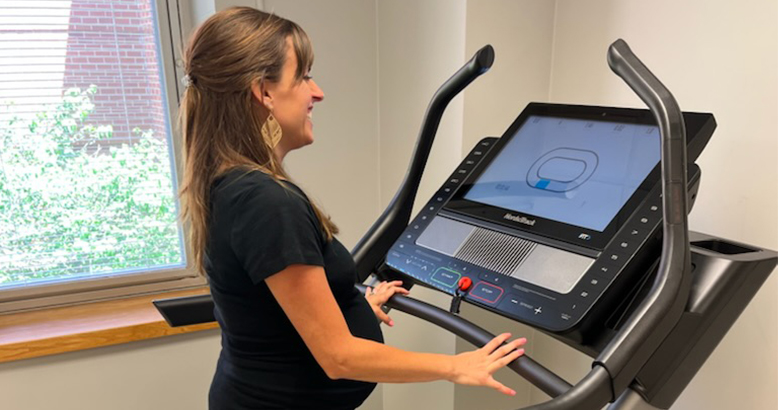The Physical Activity and Metabolism (PAM) Laboratory
The PAM Laboratory, housed within the Department of Obstetrics and Gynecology, operations are overseen by Jill M. Maples, PhD, Associate Professor. The broad mission of the Physical Activity and Metabolism Research Laboratory is to improve the lives of women and infants in East Tennessee, and beyond, through scientific investigation and research.
Why study physical activity and metabolism?
A better understanding of human metabolism and the health benefits of physical activity could inform every specialty in medicine. The initiation and progression of many chronic conditions is often accompanied by metabolic perturbations. Studying the metabolic capacity of a system or organism to functionally adapt to stress, such as a high-fat meal or a single exercise session, can provide a deeper understanding of physiological mechanisms, be essential in diagnosing disease states, and can predict future disease risk. Additionally, any physical inactivity is a modifiable risk factor for a wide variety of diseases.
Research Team
PAM Lab Leadership
|
|
|
|
|
|
PAM Lab Staff
 Lina Reyes-Fontalvo, MBBS PAM Lab Manager |
 Emily A. Olatt, BS Research Technician |
Facilities/Capabilities
The PAM Laboratory has office and lab space that is equipped for clinical and translational physiologic research. It is designed to perform metabolic and physical activity studies, including whole-body human metabolism under a variety of conditions across multiple patient populations. The space is in close proximity to clinical care, which is ideal to overcome barriers related to patient recruitment/retention and other logistical barriers related to lab access.Equipment is available for assessing whole body metabolic assessments while resting/reclining or exercising, assessing cardiorespiratory fitness, assessing resting/exercising vital signs and measuring body composition. The space is BSL-2 certified providing the capacity to collect, process, and store biospecimens.
Maternal and Fetal Metabolic and Physical Activity Research
Pregnancy has been likened to a maternal stress test that can predict a woman's health later in life. Theoretically, this period should provide an ideal time to better understand a variety of physiological mechanisms that could improve women's health. However, barriers conducting research with women that are pregnant and postpartum exist. This population is severely underrepresented in clinical trials. Overall, a relative lack of research in this population has resulted in less evidenced-based guidance, specifically related to metabolic health and physical activity during and after pregnancy.
More appropriately tailored, evidence-based, preventative clinical care delivered to women during and after pregnancy is needed to reduce physical inactivity and improve the metabolic health of women and their babies. The goal is that work done in the Physical Activity and Metabolism Lab provides evidence that will help shape metabolic and activity-related clinical care recommendations for women, particularly higher risk women, during and after pregnancy.
Pregnancy is a unique entry point for the care of women. This is an especially important time to deliver appropriately tailored, evidenced-based, preventative care because there are implications for both the immediate and future health of two individuals (mom and baby). Unfortunately, more women than ever are entering pregnancy with existing cardiovascular and metabolic disease, including obesity. Most common and troublesome pregnancy complications can be linked back to metabolic dysfunction and lifestyle. For example, physical inactivity is a modifiable risk factor for numerous health outcomes. Yet most women entering pregnancy fail to accumulate sufficient levels of physical activity for optimal health, and often, physical inactivity is underappreciated in terms of its deleterious effect on health. During pregnancy, inactive women, those with obesity, and those with other chronic diseases and complicated pregnancies have a higher risk of poor obstetric outcomes.
There is a paucity in research providing evidenced-based recommendations for optimizing metabolic health during pregnancy, particularly among women with complicated pregnancies.
Gynecologic Cancer Metabolic and Physical Activity Research
Ovarian cancer is one of the deadliest gynecological diseases, with a 5-year relative survival rate of only 49%. Currently there are no recommended screening tests for ovarian cancer and early stages of the disease have relatively nonspecific symptoms, resulting in detection at an advanced stage with a high probability of recurrence. Altered metabolism is well-established as a hallmark of tumor cells, with the most well-known alterations occurring in glycolysis resulting in the uncoupling of the aerobic respiration pathway (i.e., the Warburg effect). Relatively less work has focused on alterations in tumor cell lipid metabolism. Ovarian cancer cells utilize lipid metabolism during proliferation and metastatic progression, making lipid metabolism an attractive target for therapeutic intervention.
Markers of enhanced lipid metabolism are found in the serum of ovarian cancer patients at initial diagnosis as well as following treatment, suggesting a dysregulation in whole-body metabolism. It is possible that altered whole-body lipid metabolism could create an environment that supports increased tumor growth. Tumors themselves rely on a constant supply of nutrients to grow and proliferate throughout the body. Perhaps instead of competing with tumors for nutrients, other non-malignant tissues reprogram their metabolism to be complementary. Understanding the metabolic changes occurring in other non-malignant tissues in the body could lead to novel treatment for cancers, where the metabolism of healthy tissues is targeted.
Minimal information is available regarding changes in whole-body metabolism in ovarian cancer patients, and no study has assessed whole-body lipid metabolism in this patient population. Understanding the full scope of dysregulated lipid metabolism in ovarian cancer patients could allow further insight into the pathogenesis of ovarian cancer as well as identify potential targets for successful therapies.





 Courtney J. Riedinger, MD
Courtney J. Riedinger, MD